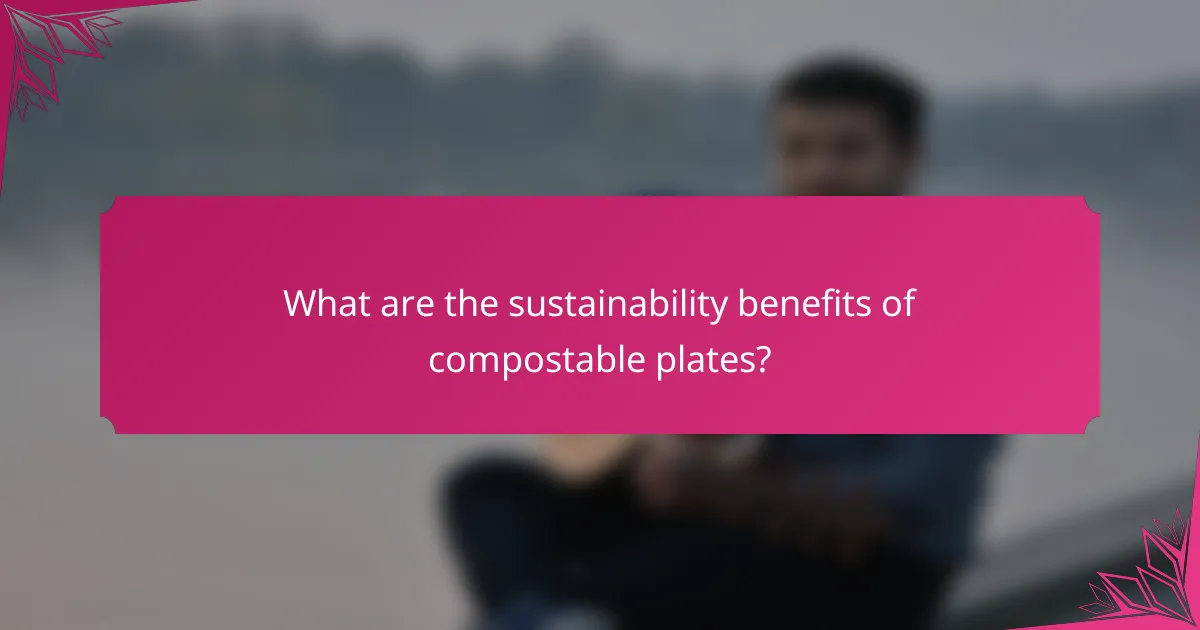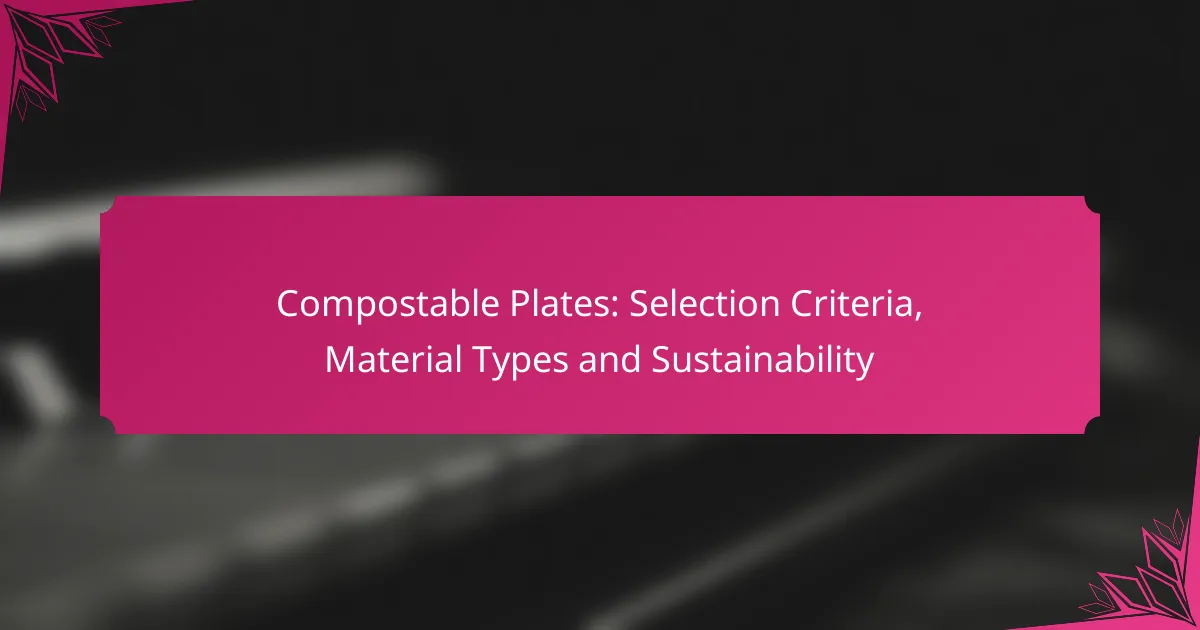When selecting compostable plates for events or businesses, it’s essential to consider factors such as material types, sizes, shapes, and cost-effectiveness to ensure they meet both functional and sustainability goals. Made from materials like sugarcane, PLA, palm leaf, and wood fiber, these plates offer eco-friendly alternatives that break down naturally in composting environments. Balancing these criteria will help you choose the best options that cater to your specific needs while promoting environmental responsibility.

What are the best compostable plates for events in the USA?
The best compostable plates for events in the USA are those that balance functionality, sustainability, and cost. Options vary in materials and design, catering to different needs and preferences while ensuring eco-friendliness.
Eco-Products Sugarcane Plates
Eco-Products Sugarcane Plates are made from renewable sugarcane pulp, making them a popular choice for eco-conscious events. These plates are sturdy, microwave-safe, and can hold both hot and cold foods effectively.
When selecting these plates, consider their compostability, which meets ASTM D6868 standards, ensuring they break down in commercial composting facilities. They are available in various sizes, making them versatile for different meal types.
Biopak Compostable Plates
Biopak Compostable Plates are crafted from plant-based materials, offering a sustainable alternative to traditional plastic. These plates are designed to be both durable and leak-resistant, suitable for a range of food items.
Look for Biopak plates that comply with composting standards, ensuring they can decompose in appropriate facilities. They come in various shapes and sizes, allowing for customization based on event needs.
Green Paper Products Plates
Green Paper Products Plates are made from recycled paper and are fully compostable, appealing to environmentally conscious consumers. These plates are lightweight yet sturdy, making them ideal for casual gatherings.
Check for certifications such as the Biodegradable Products Institute (BPI) to ensure their compostability. They are available in different sizes and designs, offering flexibility for various serving styles.
World Centric Plates
World Centric Plates are made from sustainable materials like palm leaves and sugarcane, providing a unique and eco-friendly option. They are known for their strength and ability to hold wet foods without leaking.
Consider the aesthetic appeal of these plates, as they offer a natural look that enhances event decor. Ensure they meet composting standards for effective disposal after use.
Chinet Compostable Plates
Chinet Compostable Plates are made from recycled materials and are designed for heavy-duty use, making them suitable for hearty meals. They are microwave-safe and can handle both hot and cold dishes.
When choosing Chinet plates, verify their compostability certifications to ensure they can be disposed of responsibly. They are available in various sizes, catering to different serving needs.

How do I choose compostable plates for my business?
Choosing compostable plates for your business involves considering material types, sizes, shapes, certifications, and cost-effectiveness. These factors ensure that the plates meet your operational needs while supporting sustainability goals.
Consider material type
The material type of compostable plates significantly impacts their performance and environmental benefits. Common materials include sugarcane, bamboo, and PLA (polylactic acid), each offering unique properties. For instance, sugarcane plates are sturdy and suitable for hot foods, while PLA plates are better for cold items.
Evaluate the environmental impact of each material. Look for options that are made from renewable resources and are certified compostable to ensure they break down effectively in composting facilities.
Evaluate size and shape
Size and shape are crucial for functionality and presentation. Consider the types of food you will serve and choose plates that accommodate portion sizes appropriately. Standard sizes range from 6 inches for appetizers to 10-12 inches for main courses.
Additionally, the shape of the plates can enhance the dining experience. Round plates are versatile, while square or rectangular plates can add a modern touch to your presentation.
Check certifications
Certifications indicate the compostability and safety of the plates. Look for labels such as ASTM D6400 or EN 13432, which confirm that the products meet specific composting standards. These certifications ensure that the plates will break down in commercial composting facilities.
Be cautious of misleading claims. Always verify that the certifications are from reputable organizations to avoid purchasing products that do not meet your sustainability goals.
Assess cost-effectiveness
Cost-effectiveness is a key consideration when selecting compostable plates. Prices can vary widely based on material, size, and brand. Generally, expect to pay a premium for compostable options compared to traditional plastic or paper plates.
Calculate the total cost by factoring in not just the purchase price but also the potential savings from waste disposal fees and the positive impact on your brand image. Balancing quality and cost will help you make a sustainable choice without straining your budget.

What materials are used in compostable plates?
Compostable plates are made from various materials that break down naturally in composting environments. Common materials include sugarcane, PLA, palm leaf, and wood fiber, each offering unique properties and benefits for sustainable dining.
Sugarcane (Bagasse)
Sugarcane, or bagasse, is a byproduct of sugar production and is widely used for compostable plates. It is sturdy, lightweight, and can withstand hot and cold foods, making it a versatile option for various dining needs.
When selecting sugarcane plates, look for those that are certified compostable according to recognized standards, such as ASTM D6400 or EN 13432. This ensures that they will break down effectively in commercial composting facilities.
PLA (Polylactic Acid)
PLA is a bioplastic derived from renewable resources like corn starch or sugarcane. It is popular for its clear and glossy finish, often used for single-use items like plates and cutlery.
While PLA plates are compostable, they require specific industrial composting conditions to break down properly. Home composting may not reach the necessary temperatures, so check local facilities for appropriate disposal options.
Palm Leaf
Palm leaf plates are made from fallen leaves, making them an eco-friendly choice. They are sturdy, biodegradable, and can add a rustic aesthetic to any event.
These plates are suitable for both hot and cold foods and are often used for catering and outdoor events. Ensure that the palm leaf plates are sourced sustainably to support environmental conservation efforts.
Wood Fiber
Wood fiber plates are crafted from recycled paper or wood pulp, providing a sturdy and compostable option. They are often treated to resist moisture and grease, making them suitable for a variety of food types.
When choosing wood fiber plates, look for products that are free from harmful chemicals and are certified compostable. This ensures they will break down safely in composting systems without leaving toxic residues.

What are the sustainability benefits of compostable plates?
Compostable plates offer significant sustainability benefits by reducing waste and minimizing environmental impact. They are designed to break down naturally, contributing to a circular economy and promoting healthier ecosystems.
Reduced landfill waste
Compostable plates help decrease the volume of waste sent to landfills. Unlike traditional plastic plates, which can take hundreds of years to decompose, compostable options typically break down within a few months under the right conditions. This rapid decomposition reduces the burden on landfill sites and conserves valuable space.
When composted properly, these plates can transform into nutrient-rich soil amendments, enriching the earth rather than contributing to pollution. To maximize this benefit, ensure that compostable plates are disposed of in designated composting facilities that can handle organic materials effectively.
Lower carbon footprint
Using compostable plates can lead to a lower carbon footprint compared to conventional disposable options. The production of compostable materials often involves renewable resources, which can result in fewer greenhouse gas emissions during manufacturing. For instance, plates made from plant-based materials like sugarcane or bamboo typically have a smaller environmental impact than those made from petroleum-based plastics.
Additionally, when compostable plates are disposed of in composting systems, they can help sequester carbon in the soil, further mitigating climate change. To ensure the lowest carbon footprint, choose plates certified by recognized standards, such as ASTM D6400 or EN 13432, which verify their compostability and environmental claims.
